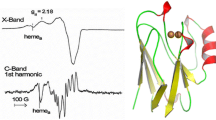Abstract
Aldehyde:ferredoxin oxidoreductase (AOR) from the hyperthermophilic archaeon Pyrococcus furiosus is a homodimeric protein. Each subunit carries one [4Fe-4S] cubane and a novel tungsten cofactor containing two pterins. A single iron atom bridges between the subunits. AOR has previously been studied with EPR spectroscopy in an inactive form known as the red tungsten protein (RTP): reduced RTP exhibits complex EPR interaction signals. We have now investigated the active enzyme AOR with EPR, and we have found an S = 1/2 plus S = 3/2 spin mixture from a non-interacting [4Fe-4S]1+ cluster in the reduced enzyme. Oxidized AOR affords EPR signals typical for W(V) with g–values of 1.982, 1.953, and 1.885. The W(V) signals disappear at a reduction potential E m,7.5 of +180 mV. This unexpectedly high value indicates that the active-site redox chemistry is based on the pterin part of the cofactor.
Similar content being viewed by others
Author information
Authors and Affiliations
Additional information
Received: 18 December 1995 / Accepted: 26 March 1996
Rights and permissions
About this article
Cite this article
Arendsen, A., de Vocht, M., Bulsink, Y. et al. Redox chemistry of biological tungsten: an EPR study of the aldehyde oxidoreductase from Pyrococcus furiosus . JBIC 1, 292–296 (1996). https://doi.org/10.1007/s007750050056
Issue Date:
DOI: https://doi.org/10.1007/s007750050056




